Plates, tools among items found on 19th-century shipwreck in Nunavut
Janet Davison
Source - http://www.cbc.ca/news/canada/erebus-terror-artifacts-1.3244303
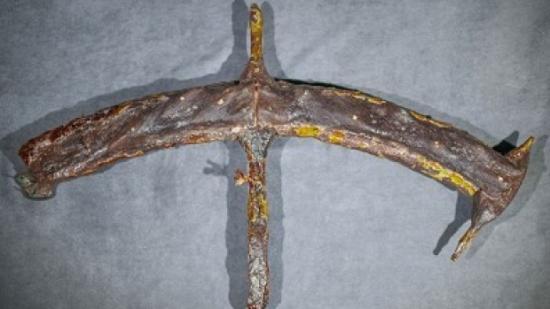 A portion of the wheel of HMS Erebus was recovered by underwater archeologists during this summer's exploration of the wreck site in Nunavut. (Parks Canada)
A portion of the wheel of HMS Erebus was recovered by underwater archeologists during this summer's exploration of the wreck site in Nunavut. (Parks Canada)
After another season of searching in the cold waters off Nunavut for the ships of the Franklin Expedition, HMS Terror remains elusive, but new photos released today show some of the 39 artifacts recovered during the latest search of the HMS Erebus wreck site.
The Parks Canada-led initiative delving into the fate of the mid-19th-century Franklin Expedition did not discover the whereabouts of Terror this summer, but underwater archeologists taking advantage of good weather spent hours on and around the Erebus wreck. They found items ranging from a portion of the ship's wheel to a sword hilt and a boot.
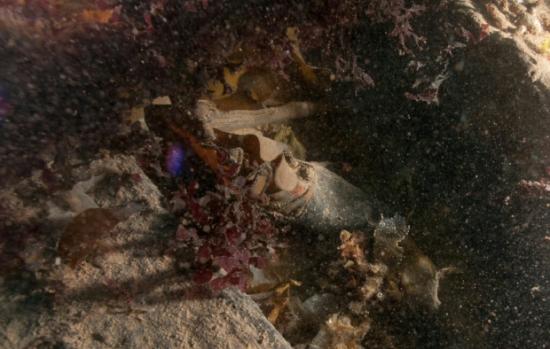 A boot was among the artifacts found during this summer's search of the wreck of HMS Erebus. (Parks Canada)
A boot was among the artifacts found during this summer's search of the wreck of HMS Erebus. (Parks Canada)
"We now have a really solid understanding of the site that will allow us to develop the best strategy for future investigations," Marc-André Bernier, manager of underwater archeology for Parks Canada, said on the agency's website.
"The artifacts recovered are only a preview of the amazing things we will find inside the ship. This shipwreck never ceases to amaze us."
The federal agency said divers had "unparalleled access to the wreck site," which was discovered last year in the shallow waters of Wilmot and Crampton Bay.
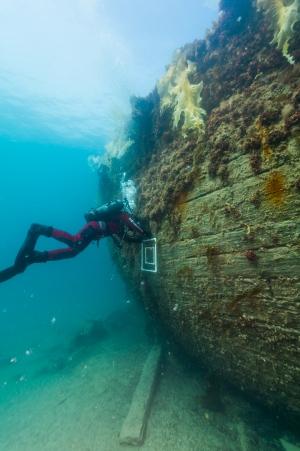 Marc-André Bernier, Parks Canada's manager of underwater archeology, sets a marine biology sampling quadrant on the port side hull of HMS Erebus. (Parks Canada)
Marc-André Bernier, Parks Canada's manager of underwater archeology, sets a marine biology sampling quadrant on the port side hull of HMS Erebus. (Parks Canada)
Numerous artifacts, ranging from plates and mariners' tools to wood, lead, copper and glass objects, were located and documented — and in some cases were moved around and became more difficult to recover after a fierce Arctic storm rolled through during this year's search season.
"It's reflective of how quickly the Arctic can change," says Adrian Schimnowski, operations director of the Arctic Research Foundation, a non-government partner in the search.
Underwater visibility that had rivalled something more typical of the tropics deteriorated, with visibility falling to half a metre after the storm. Underwater archeologists had to use markers and lines to find their way around the wreck when they returned.
It was another reminder of how unpredictable the forces of nature can be in the Arctic — the same forces that were so central to the ultimate demise of the expedition led by Sir John Franklin to find the Northwest Passage in the 1840s.
"There was a lot of power in just five days that rolled through and turned a mission that was thought to be very simple [into something] more complicated," says Schimnowski.
Life on board a shipwreck
The Arctic Research Foundation's research vessel, the Martin Bergmann, acted as the main platform for the HMS Erebus research that wrapped up on Sept. 19.
That work also included biological exploration of the wreck that lies in about 11 metres of water.
"There's actually quite surprisingly a lot of life on the shipwreck," says Schimnowski, noting different types of coral, anemones, urchins and tube worms were recorded.
A lot of kelp was also cleaned off the wreck, and detailed measurements, documentation and photos were taken in preparation for the retrieval of artifacts.
"This shipwreck is proving to be very rich in artifacts," says Schimnowski. "It will have many clues that will lead to the demise and what happened to the crewmembers."
Until now, that has been one of the great mysteries of the Canadian North — just what did happen to Sir John Franklin and his 128 crewmembers as his expedition came to its grim demise in the late 1840s.
A big clue in the mystery is the wreck of HMS Erebus, found last year in a location indicated by Inuit oral histories.
So far, though, the other reinforced wooden ship that set sail with Erebus in 1845 — HMS Terror — remains missing. Search efforts for it have focused on waters further north in Victoria Strait. This year, another 500 square kilometres were searched, "the most productive season to date," Parks Canada said.
'Pleased with progress'
The agency was "pleased with the progress that was made," even though the location of Terror is still unknown after the searchers' latest efforts.
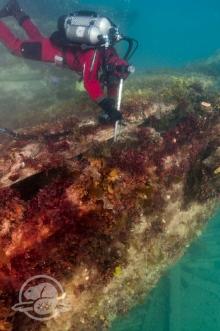 Cameras were poked inside openings in the deck of HMS Erebus to capture images of the interior of the 19th-century reinforced wooden vessel. (Parks Canada)
Cameras were poked inside openings in the deck of HMS Erebus to capture images of the interior of the 19th-century reinforced wooden vessel. (Parks Canada)
"The data they gathered will be analyzed by the Canadian Hydrographic Service to help modernize the nautical charts," Parks Canada said.
Parks Canada and the Arctic Research Foundation presented the results of this year's search efforts, along with photos from the wreck site, to residents in the Nunavut communities of Cambridge Bay and Gjoa Haven, an action Schimnowski considers important.
"It helps build new bridges and trust with the communities and we hope we continue to be a little more transparent in sharing the science that we are doing."
The photos were particularly intriguing for local children.
"Seeing a diver floating above the wreck and seeing this huge hull gives you a sense of size and scale," says Schimnowski.
"It's almost like a mission to Mars. You get them exposed to this environment through photos that you don't normally see and it just creates this huge spark of creativity. It's so important for children in these communities to see that and for us to share these stories."
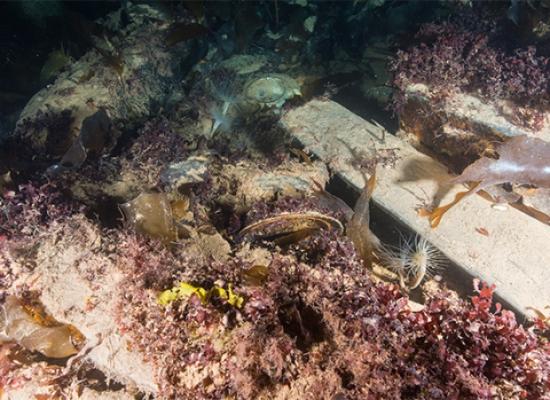
The HMS Erebus wreck provides a good habitat for a wide diversity of marine species because it is sheltered from the ice. (Thierry Boyer/Parks Canada)